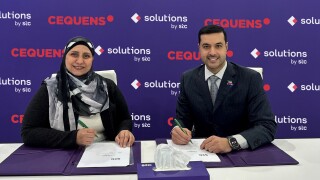
Telecom Egypt isn't leaving any stone unturned by adopting a number of untapped solutions and expanding to new markets, as well as providing extra options for those connecting with other continents. Adel Hamed, managing director and CEO at Telecom Egypt, talks of the company's current position in the market and how he sees the road ahead.
How has Telecom Egypt emerged over time as provider of a key route for international traffic from Africa and Asia to Europe?
As early as the 19th century, Telecom Egypt was investing in its international cable footprint. Back then, it was the central hub for international telegraph cables that served clients in Egypt, the wider region and beyond.
Today, thanks to its state-of-the-art technology, reliable infrastructure solutions and a wide network of subsea cables, the company provides advanced telecoms solutions to the global market at large and offers unmatched value propositions.
Telecom Egypt’s network has also positioned Egypt as a critical international hub for global communications networks that connect Africa, Asia and Europe, as its network serves as the shortest and most reliable path between continents, making it the ideal pathway for data to reach global destinations.
How does Telecom Egypt plan to maintain its role in the region into the future and what are its expansion plans?
Telecom Egypt is in constant motion to improve and extend its global reach by investing in new cables individually or through consortiums, and by connecting the Red and Mediterranean seas using advanced technological solutions.
The company currently connects 12 subsea cable systems from the East to 14 from the West, with at least five more in the pipeline. Two such cables – namely, the TE North subsea cable that links Egypt, Marseille, Cyprus and Algeria, and the MENA subsea cable that runs from Italy to India, crossing three continents and four seas – are fully owned by Telecom Egypt.
The company also owns and operates 10 landing stations positioned at various locations on the coasts of the Red and Mediterranean seas (Port Said, Alexandria, Abu Talat 1 and 2, Sidi Krir, Suez, Hod al Dars, Zaafarana 1 and 2, and Ras Gharib), in addition to an eleventh abroad in Mazara del Vallo, Italy. The landing points are connected over 10 diverse terrestrial crossing routes, providing route redundancy.
In addition, Telecom Egypt plans to expand its international portfolio to reach a total of at least 16 landing stations, 14 diversified crossing routes and 18 subsea cable systems in the next three years.
There has been news on some restructuring of the regulatory environment in relation to permits and the charges for transit traffic crossing Egypt: how do you think the new model will help the industry and new cable owners?
Telecom Egypt is very attentive to the requirements of the international community and is keen on supporting the Egyptian Government’s endeavour to promote the international submarine cable industry. In that regard, the company, following improvements to the NTRA’s [National Telecommunications Regulatory Authority] fees, has supported the regulator in putting an end to the crossing regulatory fees model. The new model is known as licence landing rights [LLR], which eliminates crossing fees.
What differentiates the LLR is that it is a technology-neutral model that helps cable owners to freely activate or upgrade their transiting subsea cable systems without worrying about the cost. The new model comes with a flat-rate cost based on the number of fibre pairs that will land in Telecom Egypt’s Red Sea landing stations, without additional activation fees being applied. This LLR will be subject to future improvements based on market dynamics, making it more convenient for our partners. Additionally, we have provided the option for cables to still use the per-activation model at a discounted licence charge, if it is deemed more economic.
On another note, the permit cycle has also improved immensely, and our clients have gained better awareness of its duration, allowing them to make informed decisions about their cable systems.
Telecom Egypt last year announced the HARP subsea system, due to go live by 2023. What differentiates this system from existing and planned subsea cables around Africa?
Telecom Egypt plans to establish open points of presence in various locations in Africa and Europe to serve its enterprise and wholesale customers, support digital transformation efforts throughout African nations, and expand the company’s international footprint. To fulfil its plans, the company is aggregating its existing and planned projects to offer end-to-end connectivity to Africa and connect both its east and west coasts to Europe via its new subsea system, the Hybrid African Ring Path (HARP), which will contribute to digitalisation across the continent.
This harp-shaped subsea system that circles the African continent will not only connect coastal countries, but also landlocked ones, with an option for them to branch out to multiple potential landing points and connect to Telecom Egypt’s IP transit nodes and data centres. With the establishment of this highly reliable and robust system, data traffic to and from Africa can be rerouted between the east and west coasts, making HARP a highly secure system.
How is the company seeking to improve cross-border connectivity with neighbouring countries?
At the regional level, Telecom Egypt is working on improving its connectivity to neighbouring countries with which it shares strong cultural and historic ties. The company has extended its trans-border network to connect to countries such as Sudan, Libya and Jordan.
In addition, it has recently signed a strategic memorandum of understanding (MoU) with Grid Telecom in Athens to connect Greece and Egypt via subsea cable infrastructure. The strategic agreement sets the grounds for the exploration of different connectivity options between the countries, and seeks to enable the optimal use of the two players’ state-of-the-art networks and international reach through their existing and future optical interconnectivity to neighbouring countries.
As a new market for Telecom Egypt, what services are you providing for those connecting in western Africa?
Telecom Egypt will soon provide the St Helena Government (SHG) with its first subsea fibre-optic solution to connect the island to Telecom Egypt’s subsea system over the Equiano subsea cable system. This is a crucial step towards the island’s economic growth.
The branch that will connect Telecom Egypt’s system to St Helena will be 1,140km long and run along Africa’s west coast, providing St Helena with access to both Lisbon in Portugal and Melkbosstrand in South Africa, with scalable connectivity ranging from a few hundred gigabits up to multiple terabits to meet varying demands. The cable offers the most cost-effective solution to meet the growth in the island’s bandwidth needs.
Harnessing its vast experience in the subsea connectivity business, Telecom Egypt, in conjunction with the SHG, will provide dynamic-circuit-network functionality, ensuring that SHG’s telecommunications partners have access to fixed bandwidth. Telecom Egypt will also provide support in terms of the design, installation and configuration of the subsea and network equipment.
This cooperation is part of the initiation of Telecom Egypt’s endeavours in western Africa, and a step forward in the company’s plans to expand its services beyond the MENA region and fortify its global presence by providing subsea solutions to global partners. The service will enable entities within St Helena to access large capacities that will improve quality of service and enhance customer experience.
Do you have plans to improve your layer-2 mesh network across Egypt?
To maintain a high level of service availability, Telecom Egypt has developed its meshed network solutions across its diverse trans-Egypt routes that reach Europe through the Mediterranean Sea and extend to Singapore. The solution promotes a network availability of up to 99.999%, allowing traffic to be rerouted as needed in less than 50 milliseconds. It also offers high-quality availability with a service-level-agreement [SLA] portal.
The services offered range from basic layer-2 to layer-3 solutions. The layer-3 mesh services are similar to those offered to Google across Egypt, which increased the reliability of Google’s international transit traffic and provided it with elevated robustness.
Recently, Telecom Egypt has deployed Ciena’s WaveLogic 5 Extreme coherent optical technology to maximise capacity along the Mediterranean segment of its MENA subsea cable system and Egypt’s mesh network. Through the new technology, the MENA Cable offers Telecom Egypt’s mesh network a new gateway to Europe through Italy, in addition to the current one in Marseille








